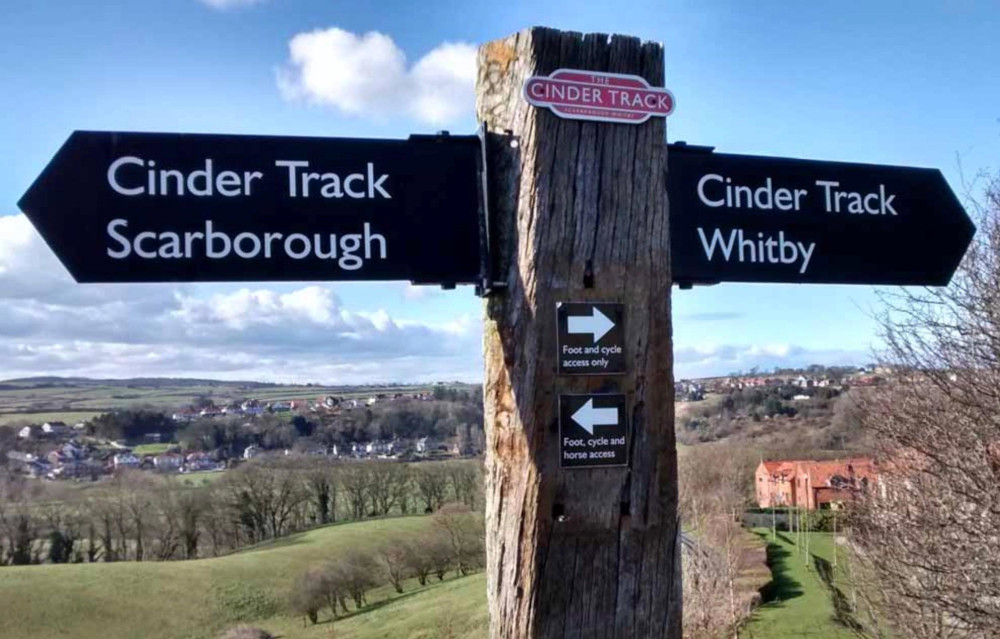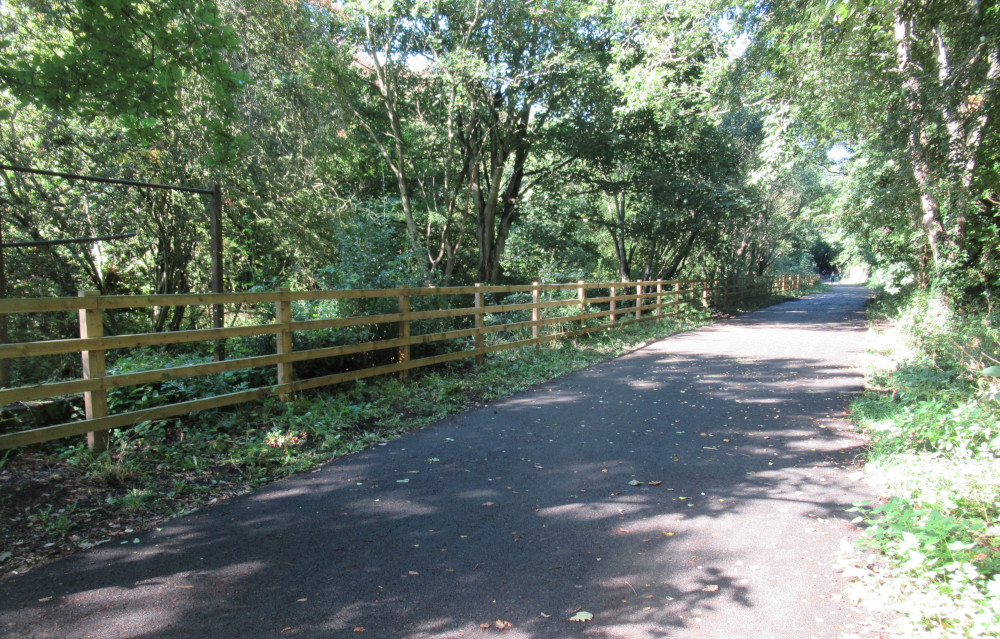Active Travel
Everything in this concern comes under the NYC Portfolio of Highways and Transportation, Cllr Keane Duncan.



Whilst Whitby and District has hundreds of miles of some of the best walking in the country on its doorstep and has many active walking groups, it has very low utilisation of bicycles as a form of transport. Whilst its geography doesn’t help, that is not really the barrier preventing its uptake. The town is sorely lacking in safe cycling infrastructure, having a single (leisure) cycle track with poor access. This is not going to overcome the reticence of residents to make use of bikes as an alternative to the car. Children have bike training when at school but subsequently have nowhere safe to make use of it. Traffic congestion during peak periods is not going to improve any time soon without a shift in attitudes and in modes of transport. Moving to electric cars will not solve the problem, not being quite as green as purported (electric comes from somewhere and the UK does not have generating capacity for this, battery components come from somewhere, and so on), and still occupying the same space on the road, with private car ownership having been determined as unsustainable by the UK Government.
The York and North Yorkshire Local Enterprise Partnership stated that for the region to get to carbon negative, cycling will have to increase 900% and car usage decrease by 48% by 2030. We have to get an amount of the public to use active travel and public transport for local journeys, and only use the car for longer trips, and this will require significant investment in cycle infrastructure.
Please note that subsequent to our initial campaigning on active travel, particularly for a Whitby LCWIP, as well as our proposals for a cycle network, the Whitby & Esk Valley Active Travel charity (charity no. 1206506) was formed to take those ideas forward. Please refer to their website and contact them for all future developments.
Cycle Infrastructure
The need for cycle infrastructure is covered by Whitby & Esk Valley Active Travel on this page.
Cycle Infrastructure Plans
Local Cycling Walking Infrastructure Plan
A Local Cycling and Walking Infrastructure Plan (LCWIP) provides a definition of required cycling and walking paths to meet the needs of the residents of an area, to get between residential, leisure, retail and work locations for example. This is seen as a pre-requisite by ActiveTravel England for obtaining any funding for cycling infrastructure schemes, providing a series of bid-ready proposals that can be submitted for funding. Whitby doesn’t have such a plan.
The following towns in North Yorkshire have LCWIPs (with the population in parentheses), all funded by NYC (largest town in each of the 7 boroughs), with the exception of Ripon which was funded by S106 monies :- Harrogate (75k), Scarborough (52k), Selby (25k), Northallerton (18k), Ripon(16k), Catterick Garrison (15k), Knaresborough (15k), Skipton (14k), Malton (12k), Richmond (8k), Sherburn-in-Elmet (6k), Tadcaster (6k). What would make sense would be to provide an LCWIP for all towns with a population of, say, 10000 or more, meaning only Whitby and Thirsk would need one developing, and then be in tune with Sustrans strategy of linking all populations of 10000 or more.
An LCWIP is claimed to require the order of £50-80k to develop (if one would cost that for a town the size of Harrogate, why would Whitby cost the same?), NYC decided there was insufficient funding to develop one for towns like Whitby, and didn’t see sense to require development of the Broomfields estate (HA18) to provide sufficient S106 monies to provide one for Whitby. In practice this absence of an LCWIP means that no funding for Whitby cycling infrastructure schemes will be bid for by NYC until such a document exists and they will instead concentrate on the areas they consider “more important”. So much for the “900% increase in cycling” here then.
This story was picked up by the Whitby Gazette on 30/08/2022, and has had feedback from readers, including this reply from a local GP highlighting the health benefits to be had, the inadequacies that we have to face currently, and the need to provide infrastructure. Putting this in the context of the UK Government trialling active travel “by prescription” from GPs in certain areas, without cycle infrastructure such a scheme would be doomed to failure, and so of no value here currently. As a result of this campaigning, in October 2022 NYC submitted a bid to the Active Travel England “Capability and Ambition Fund” for funding to provide an LCWIP for Whitby. In January 2023 we were informed that this application was not successful (in applying for the £55k required). We enquired whether we could bid for funding from one of the York and North Yorks Local Enterprise Partnership funds, and were informed that they would check with their colleagues (in NYC).
Status : NYC notifed us on 14th February 2023 that they will be using their own funds in the 2023-2024 financial year to provide a Whitby LCWIP.
Whitby & Esk Valley Active Travel were a consultee on the Whitby LCWIP, with the LCWIP document finally adopted by NYC in May 2025.
Other Active Travel Plans
In 2020, NYC applied for and received Active Travel Fund (Tranche 2) to provide walking and cycle infrastructure for the route of the Whitby Park and Ride bus. Upon planning, this scheme only amounted to the length of Guisborough Road, including a crossing to provide access to a car boot sale site. Many residents raised concerns about this not being of any benefit to residents (solely day visitors), and having been applied for without any form of approval by the populace. In 2022 the car boot location no longer exists, and the schema still has not been started. Whitby Town Deal were reported to being able to extend this proposed scheme down Mayfield Road with connection to CinderTrack and Caedmon College, but no public domain confirmation of this was available; this has subsequently not made it to the delivery phase of Whitby Town Deal. Update : apparently the money bid for will not be sufficient to complete this scheme so NYC have decided to allocate all funds to a scheme in Harrogate. Unless such a proposed route reaches beyond Guisborough Road it will provide ZERO benefit for residents of this town. Additionally NYC found that it would have been impossible to provide a compliant cycle scheme down Guisborough Road due to road width.
In 2021, NYC submitted a seemingly unambitious bid for Active Travel Fund (Tranche 3) funding not including anything for Whitby, and failed to receive anything. The message from that round of funding seemingly being, be ambitious and follow UK Gov LTN 1/20 when designing schemes. In 2023, NYC submitted a bid for £3m+ for Active Travel Fund (Tranche 4) funding not including anything for Whitby, and failed to receive anything.
Note also that NYC apparently do not currently store information about cycle paths in terms of mapping information, only just starting a process to map what exists; that does not put them in a good position to develop an active travel infrastructure network across the whole county, and so an amount of work needs doing before moving forward. In their 2016 Transport Plan document they state that “much of the 9000km of the road network in North Yorkshire is eminently suitable for cyclists”; this diverges from the public perception somewhat (70% consider roads too dangerous) and also from the UK Government LTN 1/20 document, and they don’t have a clear plan on how to encourage people to utilise bikes for not just leisure activities but also as a form of transport. This Transport Plan is urgently in need of update, with no mention of LCWIPs or LTN 1/20 (which was originated since its publish date), and we understand that an updated version should be available around April 2024.
SBC unveiled the Whitby Blueprint 2021 as supposedly a development plan for Whitby through to 2035. It has all of 3 sentences that touch on cycling. With respect to the CinderTrack “Enhancements to the arrival on the track at Whitby will be promoted, with clearer and more inviting routes into the Town Centre. It is envisaged that through interventions along Southend Gardens and an improved crossing on Chubb Hill Road, a route though Pannett Park past the Gallery and Museum can be established” – so that is a road crossing into Pannett Park for visitors! And then the only other mention is a vague “enhancement of our walking and cycling network”. Well there is currently no “cycling network” so “enhancing” it is radical. There is no mention of providing an LCWIP document for the Whitby area. The document is utterly lacking in any ambition, detail, or commitment for active travel, and the active travel aspect needs completely rewriting with a view to unlocking the benefits of cycling for Whitby residents, and to redress the years of underinvestment in Whitby. We can only assume that it was developed by people with no understanding of the town, or of the need for use of the bicycle as a form of transport to offload the use of the car. It is superceded by the Vision for Whitby 2023 consultation. In contrast the same organisation developed the Scarborough Blueprint 2021 which contains plans for 16km of quality cycle paths in addition to what is already present (16.8km), covering 4 corridors, following the existing Scarborough LCWIP. So that is an ambition to take Scarborough to 32.8km of cycle path. Great, so SBC were capable of showing ambition in active travel when they want to, just seemingly not in Whitby.
Bearing in mind NYC have have stated ambitions to be the first “carbon-negative” council area by 2040/2050 (delete as appropriate), their current plans will need significant development over the coming year or so to back up the ambitious statement (and achieve anything like the 900% increase in cycling).
We emailed NYC about the current situation and when Whitby will be considered for Active Travel infrastructure in September 2022 and received this reply.
Our Strategy
NYC does not have any (public-domain) plan for development of cycle infrastructure in Whitby and District. The LCWIP is scheduled to be provided in the 2023-2024 financial year. Consequently the delivery of cycle paths will almost certainly not be before 2026-2027 at the earliest. Their record on delivering cycle infrastructure plans to fruition is poor, yet they are quick to preach to people that they should cycle more, let alone their public statements about climate change which would require major cycling investment to be realisable, but lacking an action plan to realise it.
Our strategy is as follows
- We require cycle infrastructure for connecting areas of the town and district. We have developed our own cycle infrastructure network map proposal that could form the basis of any future LCWIP for Whitby and District, as well as the basis for funding applications. Our campaign to improve the cycle path network around Whitby and District has received support from the health and educational sectors.
- We should have a 20mph speed limit in town centre and residential areas to allow active travel safety getting around the area. This provides the most cost effective way of allowing cycling within areas, since infrastructure (were it even possible) would be significantly more expensive than imposing a simple 20mph limit. We have joined the 20sPlenty campaign to further this aim.
We encourage North Yorkshire Council to implement this strategy; achieving a 900% increase in cycling by 2030 will not happen without both of these elements. With Active Travel England now assessing councils for their ability to deliver on active travel schemes, and having powers over funding for much of the transport budget, we await changes to the current unsatisfactory arrangement.
Active Travel Funding
The above plan would be a great start point, but without funding it would sit on a shelf. It should be noted that in 2020 the UK Government committed £2bn for the subsequent 10 years for active travel development, including establishing Active Travel England. In order to achieve the UK Government targets of numbers of people cycling by 2030 it is estimated that Active Travel England will require between £9bn (if they concentrate on city areas only) and £18bn (if they spread the funding equitably across all parts of the country); this being revealed at a Transport Select Committee meeting in September 2022. We can but hope the UK Government chooses the latter strategy or Whitby and District will be stuck in the cycling dark ages for years to come, never mind NYC’s strategy of becoming “carbon negative” being utterly unrealisable.
Active Travel and the Planning Process
The interface between the planning system and active travel infrastructure is currently inadequate. Referring to the 2007 SBC Transport Assessment document for new developments, any planning application has to answer “What measures can be undertaken to encourage (iv) travel by walking, cycling and public transport“. New developments are given approval with little concrete plan for active travel infrastructure, and where there is an apparent condition of approval on some infrastructure being “proposed” it almost never materialises, as a result that question in the transport assessment is not being answered to any measureable degree. The fact that the town has never had anything worthy of calling a “cycle network” previously may well have been a significant factor in this, since having a network in place would have allowed planners to insist on the construction of path(s) to new developments as part of the planning approval, rather than just S106 monies that council then squander on something unrelated. The SBC Local Plan states that “proposed housing allocations within reasonable distance to the Cinder Track in Whitby will be expected to make a contribution to the Cinder Track development”, like happened on the Barratts “Prospect Rise” development; that development < 50m from the track yet still has no connection to the track 2 years after development completion, highlighting the flaws in the current system (the S106 monies apparently spent on the actual track rather than any connection to it). Active Travel England becoming a mandatory consultee on planning applications from April 2023 offers some hope that things may improve for (larger) new build estates.
Often in the selling of new homes, housing developers make claims about the proximity of many kilometres of cycle and walking path. Whilst this is likely beyond the reach of the planning process, it is often a source of dishonesty. Development after development claim access to Whitby town centre with the CinderTrack, which is utter rubbish, covering over the fact that there is no “network” currently. What can be done is for the local authority to provide a (up-to-date) website of cycle and walking infrastructure for the local area. This would provide a way of promoting active travel to the resident, but also to the visitor. NYC do have an online map of their own paths and bridleways, but it does not show (all) cycle infrastructure, and it does not use the clearest user interface for displaying that information.

